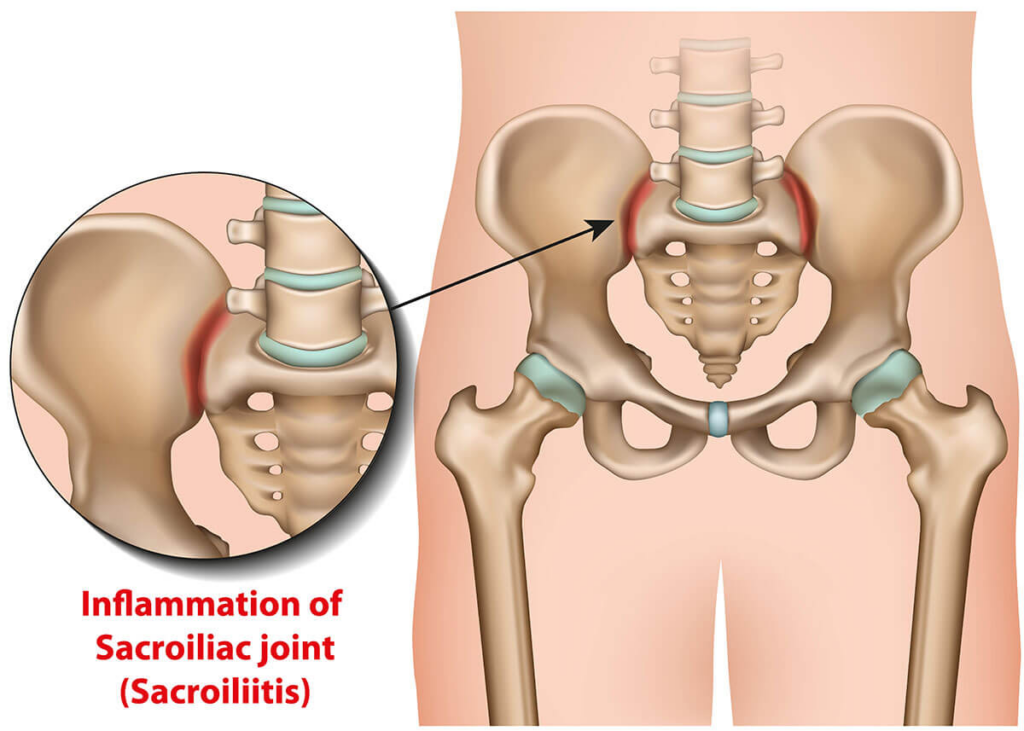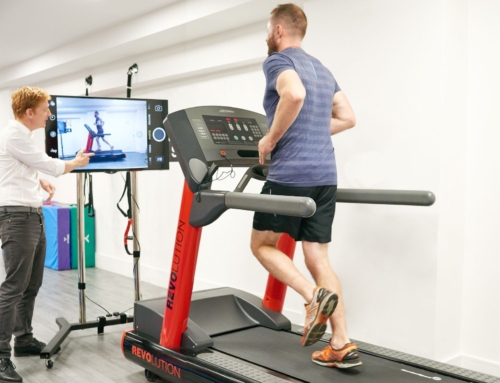What is sacroiliac joint (SIJ) pain?
It is a condition that affects one or both sacroiliac joints; there are two joints that sit where the lower spine meets the pelvis. SIJ pain causes pain and stiffness in the buttocks or lower back, and the pain might go down one or both legs.
“Sacroiliitis” is a term that is often used interchangeably with the term “sacroiliac joint dysfunction/pain”, as technically both terms can be used to describe pain that arises from the sacroiliac joint. However, although they are similar, there are very important differences in the two conditions that should be understood.
Firstly, the terms; the word ‘itis’ means inflammation, therefore “sacroiliitis” refers to inflammation of the sacroiliac joint. This would be visualised on an MRI scan. “Sacroiliac joint dysfunction” refers to the abnormal movement of the sacroiliac joint, there is no specific inflammation. This would not be visualised on an MRI scan, but can still cause significant pain. If there is either too little, known as “hypomobility” or too much movement, known as “hypermobility” in the sacroiliac joint, it can result in pain, and dysfunction.
If “inflammation” is the primary cause i.e. “sacroiliitis”, this is usually associated with conditions such as osteoarthritis or other rheumatological complaints, specifically a condition called Ankylosing Spondylitis (AS). This can be seen in both younger and older patients and should be considered as a potential cause of lower back pain at any age.
Pain caused by “sacroiliac joint dysfunction” affects both men and women of all ages, but is more common in active females aged between 20-40, and is especially prevalent in sports people and pregnant women.
Anatomy
The sacroiliac joints are the largest joints in the body. You have one each side that connects the hip bones (iliac crests) to the sacral bone (the triangular bone between the lumbar spine and the coccyx).
The joint has strong ligaments surrounding it, some of which extend across the back of the pelvis. Muscles that support sacroiliac joint function include the gluteus maximus and the piriformis muscle.
This extensive network of soft tissues provides support to the joint and assists with absorbing pressure.

The main functions of the SIJ is to provide strength, and balance the forces between the upper and lower body, and also to act as a shock absorber for these forces.
Other important functions include:
- Facilitating spinal and lower leg movements.
- Helping support the weight of the upper body.
- Facilitating pregnancy and childbirth.
While technically the SIJ is a typical synovial joint, unlike other synovial joints in the body, it has very limited motion. Full movement at the joint is only achieved when the hip joint has reached its farthest range, such as rotating the hip outwards to the end of range.
What Causes Sacroiliac Joint Pain?

As previously mentioned, problems with the SIJ arise when there is either too much (“hypermobility”), or too little movement (“hypomobility”) within the joint or joints which leads to pain and inflammation.
The cause of “hypomobility” is usually due to spondyloarthropathies that inflame and stiffen your sacroiliac joints, such as in Ankylosing Spondylitis (AS), Osteoarthritis, Psoriatic Arthritis.
Hypermobility of the joints tends to be more related to movement dysfunction. These are some of the more common causes of movement dysfunction:
- Trauma – Ligaments can become loose or damaged following an injury or fall.
- Leg length – If there is an imbalance between your leg lengths it can cause an abnormal gait pattern, increasing the forces going through one side of your SIJ.
- Muscle imbalances – your core muscles and your deep gluteal muscles are essential for controlling SIJ movement. When these muscle groups are weak or lack endurance, your sacroiliac joints are potentially vulnerable to excessive movement, and instability, leading to SIJ pain.
- Obesity – added stress and strain on the SIJs can increase the likelihood of developing pain.
- Repetitive strain – Certain manual jobs or sports may cause repeated strain on your SIJ and the soft tissue structures around it.
- Pregnancy and childbirth can put an extra amount of stress on the SI joints causing joint inflammation. Pregnancy hormones also cause ligaments to become lax, adding to movement impairment and pain in the SI Joints. If you are pregnant or post-partum we would advise you to see one of our women’s health specialist physiotherapists.
- Infection – in rare cases, SIJ pain can be caused by an infection in your body. If you are suffering from pain in the SIJ and are also feeling unwell, have a temperature and feel tired all the time then you should see your GP for further investigations.
What are the Symptoms of Sacroiliac Joint Pain?
The signs and symptoms of SIJ pain usually start in the lower back and buttocks, and may radiate to the lower hip, groin or upper thigh. While the pain is usually one sided, it can occur bilaterally (on both sides). Some patients also experience numbness or tingling in the leg or a feeling of weakness in the leg.
Common symptoms include:
- Pain with prolonged sitting, standing, walking or climbing stairs.
- Pain when transitioning from sit-stand or lying to sitting.
- Difficulty getting in/out of the car.
- Pain turning over in bed.
If the cause of the problem is due to joint pathology and inflammation, then you may also experience pain at night, and stiffness in the lower back that is often worse first thing in the morning.
How is Sacroiliac Joint Pain diagnosed?
Accurately diagnosing sacroiliac joint pain can be difficult because SIJ symptoms can mimic other common back conditions. A thorough assessment by an experienced Physiotherapist is one of the best methods to diagnose sacroiliac joint pain.
Your Physiotherapist at Complete Physio can provide a clinical diagnosis. They will carry out a comprehensive subjective and clinical assessment. Firstly they will ask you questions about your symptoms and aggravating and easing factors, as well as your exercise regime, and normal daily activities. This will help to build up a picture of what is the likely cause of the problem.
After this subjective interview, the therapist will complete a series of clinical tests that will confirm their diagnosis; depending on the severity of your symptoms, this may include:
- Measuring your hip and spine range of movement.
- Testing your muscle strength, especially your core and gluteal muscles
- Carrying out a specific set of “SIJ provocation tests”.
- Looking at your gait (walking) pattern
- Watching you move and do certain functional tasks, such as squatting, bending, hopping, running, moving from sit to stand or lying to sitting.
- Assessing your posture in sitting and standing
- Measuring your leg length.
- Checking other regions of the body; such as knees, hips, feet and lower back, to determine if other areas are contributing to the problem.
- Gently and skilfully, feeling around your pelvis, lover back and sacrum, to find exactly where it is most painful.
Imaging Tests
X-rays can diagnose/exclude some bone pathologies such as fractures and osteoarthritis, but an MRI is probably the diagnostic test of choice. MRI may show signs of sacroiliac joint inflammation or eliminate potential pathologies, especially within the lower back, pelvis and hip complex.
Blood tests
Blood tests look for signs of inflammation, infection and certain rheumatological conditions that might be the cause of your symptoms.
Steroid injection
An injection of steroid and anaesthetic into the sacroiliac joint can be used as both a diagnostic test, and also treatment. If it relieves your pain, then it can confirm that the SIJ is the structure causing your symptoms. These are not carried out at Complete Physio, but we work closely with pain and orthopaedic consultants who perform these procedures.
How is Sacroiliac Joint Pain Treated?
Successful treatment of SIJ pain relies on a multifaceted approach, and it is therefore important that you see an experienced healthcare professional. At Complete Physio, we have an exceptional team of Physios who are well trained and who see many patients with this condition.
In most cases, sacroiliac pain will improve with rest and activity codification, medication and a course of physiotherapy guided rehabilitation.
Your treatment will determined by a number of factors:
- Age
- Normal activity level
- Severity of the problem
- Pain levels
- Whether the problem is caused by an inflammatory condition, pregnancy or joint dysfunction
Sacroiliac Joint Dysfunction
Initially your physiotherapy will focus on pain relief techniques, such as joint mobilisations, manipulations, acupuncture and soft tissue release. Your Physio may suggest wearing a support belt to help stabilise the joint until your own muscles can provide better control and stability. Manual therapy techniques will be used to address any asymmetry in the alignment of your pelvis and /or leg length.
Exercises are prescribed based on the findings of your assessment and the identified deficits. You will likely need to follow an SIJ focused exercise protocol to specifically work on your core and gluteal muscle weakness.

In the longer term, your Physiotherapist will focus on restoring your activity level and function by ensuring you have good global muscle strength and movement throughout your body, allowing you to safely return to your desired activities. It might also be beneficial for you to complete a course of Pilates which has shown to have huge benefits to your core strength and is a great way to treat SIJ dysfunction.
Your physiotherapist will tailor your rehabilitation to ensure you achieve your own specific goals.
Pregnancy/Childbirth
If you are experiencing sacroiliac joint pain during pregnancy or following childbirth, we have a specialised women’s health team of physios, who will be able to give you a full assessment and specific pelvic health advice and treatment.

Inflammatory Conditions
If the cause of your SIJ pain has been identified as a rheumatological condition, then it might be appropriate to refer you to a specialist consultant for further investigations and treatment. If this is the case, then we will make sure your referral pathway is smooth, and that you receive the best possible treatment from one of the highly experienced Rheumatology consultants that we work very closely with in London.
What can I do if Physiotherapy isn’t helping?
In difficult cases that fail to respond to physiotherapy, an injection may be required to help relieve the pain.
The most common type of injection is a cortisone (steroid) Injection. Due to the complex anatomy of the SI joint, injections should be performed under imaging guidance to ensure improved accuracy and effectiveness of the treatment. These are not carried out at Complete Physio, but we work closely with pain and orthopaedic consultants who perform these procedures.
Throughout your treatment at Complete, your clinician will ensure that you feel supported, and have an active involvement in your recovery process. We will regularly reassess your symptoms and objective markers to track your goals. We have an exceptional team of specialists who are dedicated to getting you back to full function and enjoying life to the full.
If you would like to speak to one of our expert physiotherapists or to book an appointment please call 020 7482 3875 or email info@complete-physio.co.uk
Don’t let pain hold you back, book now!






